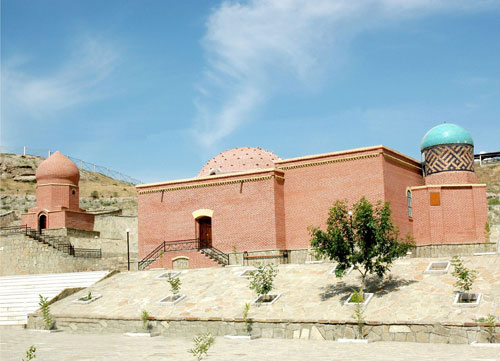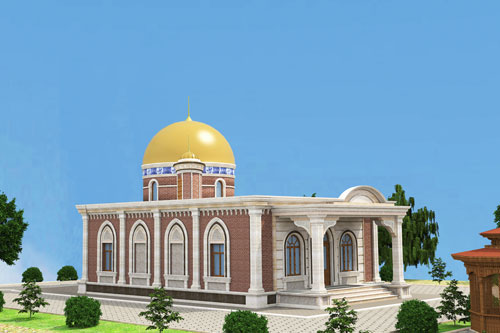IMAMZADEH COMPLEX IN NAKHCHIVAN CITY
(XVIII century)

Imamzadehs located in the territory of Nakhchivan played very crucial role in socio-political life. One of them is the Imamzadeh complex, located in the southern part of Nakhchivan city.
The base of the complex is the tomb. On the upper part of the monument built in square from the base, on cylindrical basement, the architect wrote the word “Allah” repeatedly as an epigraphic incentive with the red and purple colored bricks.
There is a grave inside of the tomb. According to the residents of the city, the son of Imam Rza, imam the eights, was buried here.
Long ago there was inscription over the tomb. According to the inscription investigated by the researcher in the XX century, the tomb was built by the order of Hazrat Rufai, the son of Haji Fulad in the period of Safavid Shah Abu Muzaffar Tahmasib Bahadur khan.
The building with entrance in the west side and relatively large size connected to this tomb was mausoleum of Nakhchivan khans. The deceased of Khan’s family were buried here until the establishment of Soviet regime. There is a tomb built of burnt bricks and covered with the dome in the north, not far from the complex.
Imamzadeh complex was restored in 2008 by the order of Chairman of the Supreme Assembly of Nakhchivan Autonomous Republic.
PARCHY (KHANLIGLAR) IMAMZADEH
(XVII-XVIII centuries)

Among the Turko-Islamic cultural monuments, Imamzadeh built in Parchy village of Sharur district in XVII-XVIII century attracts attention with its unique architectural features. Parchy, once a separate village of Sharur region is located in the north of Khanliglar village. Later two villages merged and Parchy became the part of Khanliglar village.
Imamzadeh of Parchy is located in the north part of Khanliglar village. There is a grave in the central hall of Imamzadeh, consisting of a big building with a dome. The name “Imamzadeh” indicates that it belongs to one of the children of Imam. History reveals that Museyi Kazim, imam the seventh, had many children. One of his sons is called Ibrahim. According to local people, this grave belongs to him.
Imamzadeh of Parchy was restored in 2016 by the order of Chairman of Supreme Assembly of Nakhchivan Autonomous Republic.
NEHRAM IMAMZADEH
(XVIII century)

Imamzadeh of Nehram is an example of architectural monuments related to the Islamic Saints in the eighteenth century in Nakhchivan. The imamzadeh complex is situated in the south of Nehram village of Babek district. The complex consists of tombs, mosques, tekke and other buildings. There is a grave inside the tomb which forms the basis of the complex. According to the people seid Agil, the son of imam Musa Kazim was buried in the tomb.
There are inscriptions painted on gypsum and tiles on the walls inside of the tomb. The text of these inscriptions consists of religious sayings. Above the altar of the monument, inside of the frame the text of one of these inscriptions says: O Lord! O Muhammad! O Ali! It is written "O Allah, Muhammad, Ali, Fatima, Hasan and Huseyn 138" inside of another frame.
The 138 figure mentioned in the book reflects the history of the tomb. However, the line of inscription, some historical facts and the architectural features of the mausoleum give the basis to say that it was built in 1138 hijri-lunar calendar (miladi 1725).
This complex in the village of Nehram was built at the same time with the Nakhchivan İmamzadeh during the reign of the Safavid Shah Tahmasib II.
The restoration works in Imamzadeh complex were conducted by the order of the Chairman of Supreme Assembly of Nakhchivan Autonomous Republic in 2017.


